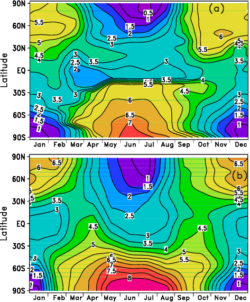Simulating Mesospheric Metal Layer Using WACCM
Upper Atmospheric Studies: Simulating Mesospheric Metal Layer Using A 3D Global Atmospheric Model
 The upper atmosphere (50-150 km) is a region which is affected both by anthropogenic activities from the surface and space weather above. It is also potentially involved in climate feedback processes. Dr. Wuhu Feng at NCAS is working with Professor John Plane at School of Chemistry, Professor Martyn Chipperfield at School of Earth and Environment, Dr. Daniel Marsh at US National Center for Atmospheric Research (NCAR), Dr. Diego Janches at NASA Goddard Space Flight Center (GSFC) as well as other scientists in USA, Germany to study the meteor astronomy, chemistry and transport processes that control the different metal layers in the mesosphere.
The upper atmosphere (50-150 km) is a region which is affected both by anthropogenic activities from the surface and space weather above. It is also potentially involved in climate feedback processes. Dr. Wuhu Feng at NCAS is working with Professor John Plane at School of Chemistry, Professor Martyn Chipperfield at School of Earth and Environment, Dr. Daniel Marsh at US National Center for Atmospheric Research (NCAR), Dr. Diego Janches at NASA Goddard Space Flight Center (GSFC) as well as other scientists in USA, Germany to study the meteor astronomy, chemistry and transport processes that control the different metal layers in the mesosphere.
Since 2013, they have successfully developed the first global atmospheric model of meteoric metals (e.g. Feng et al., 2013) based on the NCAR Community Earth System Model (CESM). Following this, they are able to build a self-consistent model to form the meteoric smoke particles using the implication metal chemistry in the mesosphere and lower thermosphere for the first time and can address the long unsolved problem in determining the magnitude of cosmic dust into the atmosphere.
Reference:
Feng, W., D. R. Marsh, M. P. Chipperfield, D. Janches, J. Hoffner, F. Yi, and J. M. C. Plane (2013), A global atmospheric model of meteoric iron, J. Geophys. Res- Atmos., 118, 9456--9474.
